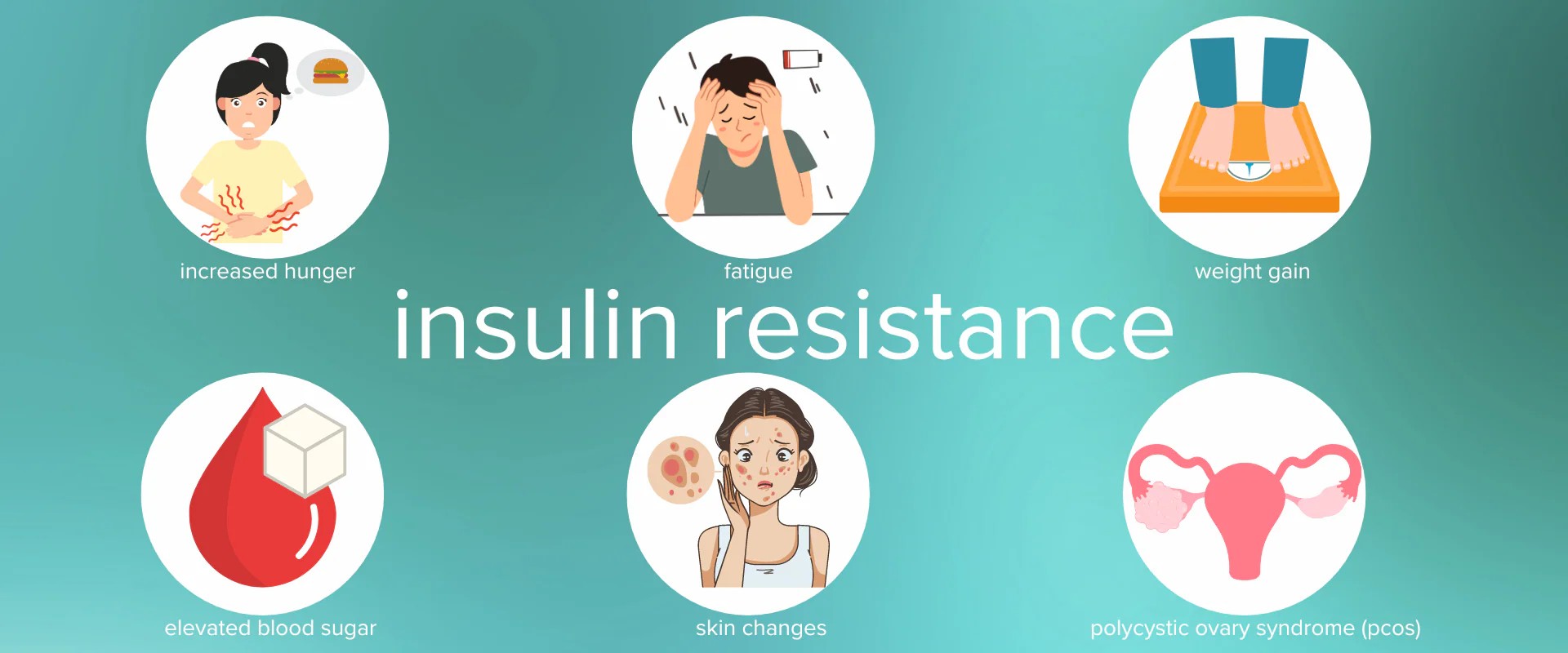Insulin resistance is a metabolic condition in which the body’s cells respond less effectively to the hormone insulin. Insulin is crucial for regulating blood sugar (glucose) levels, as it helps cells absorb glucose from the bloodstream for energy. When cells become insensitive to insulin, the body requires higher insulin levels to maintain blood sugar, leading to hyperinsulinemia and eventually a cascade of metabolic and health problems.
Over time, insulin resistance can lead to complications affecting nearly every organ system, including metabolic disorders and cognitive impairment. Below is a detailed discussion of insulin resistance and its potential consequences.
Mechanism of Insulin Resistance
Insulin, produced by the pancreas, helps muscle, fat, and liver cells absorb glucose from the blood for energy. In insulin resistance, the response of these cells to insulin becomes impaired, resulting in excess glucose remaining in the blood. This triggers the pancreas to secrete even more insulin to compensate. While effective in the short term, over time the pancreas may fail to meet the increasing demand, causing elevated blood glucose and potentially progressing to prediabetes or type 2 diabetes.
Common Symptoms of Insulin Resistance
Early-stage insulin resistance may not cause obvious symptoms, but several signs may indicate its presence:
- Increased hunger (especially after meals): Despite high insulin levels, cells cannot absorb glucose efficiently, leaving the body feeling unsatisfied and hungry after eating.
- Weight gain, particularly abdominal: Insulin promotes fat storage, especially in the abdomen. Those with insulin resistance often struggle to control their weight.
- Fatigue: Even with elevated insulin, cells cannot effectively utilize glucose for energy, leading to persistent tiredness.
- Dark skin patches (acanthosis nigricans): Velvety, darkened skin often appears on the neck, underarms, and groin, associated with insulin resistance.
- Hyperglycemia: Elevated post-meal blood sugar, which can progress to prediabetes or type 2 diabetes.
- Hypertension: Insulin resistance reduces vascular elasticity and increases blood pressure.
- Abnormal cholesterol and triglycerides: Typically characterized by low HDL (“good” cholesterol), high LDL (“bad” cholesterol), and high triglycerides, raising cardiovascular risk.
- Difficulty losing weight: Even with proper diet and exercise, weight loss remains challenging due to impaired glucose and fat metabolism.
Consequences of Insulin Resistance
1. Type 2 Diabetes
One of the most common consequences of insulin resistance is type 2 diabetes. As insulin resistance worsens and the pancreas cannot sustain high insulin output, blood sugar rises, eventually leading to diabetes — a lifelong condition with potential complications such as kidney failure, vision loss, and amputations.
2. Skin Tags
Small, benign skin growths, especially in skin folds (neck, armpits, groin), are associated with high insulin levels.
3. Stroke
Insulin resistance promotes atherosclerosis (hardening of the arteries), increasing the risk of stroke due to clots and reduced cerebral blood flow.
4. Heart Disease
Insulin resistance is a major risk factor for cardiovascular disease, contributing to high blood pressure, abnormal lipids, inflammation, and vascular damage.
5. Obesity
Insulin resistance and obesity reinforce each other, especially central (abdominal) obesity, creating a vicious cycle.
6. Migraines
Research suggests insulin resistance may trigger migraines via blood sugar fluctuations and inflammation.
7. Dementia
Insulin resistance is linked to cognitive decline and dementia, including Alzheimer’s disease (sometimes called “type 3 diabetes”), due to impaired brain glucose utilization and neurodegeneration.
8. Osteoarthritis
Insulin resistance accelerates joint wear through inflammation and increased weight load from obesity.
9. Childhood Obesity
Insulin resistance is increasingly seen in overweight children, raising the risk of early-onset type 2 diabetes and lifelong metabolic problems.
10. Polycystic Ovary Syndrome (PCOS) & Infertility
Insulin resistance raises androgen levels, disrupting ovulation and causing irregular periods, infertility, acne, and hirsutism in women.
11. Nonalcoholic Fatty Liver Disease (NAFLD)
Excess insulin promotes liver fat storage, causing inflammation and potentially progressing to cirrhosis and liver failure.
12. Arthritis
Insulin resistance increases systemic inflammation, worsening rheumatoid arthritis and other inflammatory joint diseases.
13. Alzheimer’s Disease
As noted above, brain insulin resistance contributes to memory loss and amyloid plaque formation, hallmarks of Alzheimer’s.
14. Erectile Dysfunction
Vascular damage and impaired blood flow from insulin resistance can cause erectile dysfunction in men.
15. Sarcopenia
Impaired insulin action reduces muscle protein synthesis, leading to muscle loss, weakness, and frailty in the elderly.
16. Hypertension
Elevated insulin promotes sodium and water retention, increasing blood pressure and vascular damage.
17. Metabolic Syndrome
A cluster of conditions — high blood pressure, high blood sugar, abdominal obesity, and abnormal lipids — driven largely by insulin resistance.
18. Sleep Apnea
Obesity and insulin resistance increase fat deposits around the airway, raising the risk of obstructive sleep apnea.
19. Depression
Chronic metabolic stress and inflammation associated with insulin resistance are linked to mood disorders.
20. Reduced Libido
Hormonal imbalances, fatigue, and psychological burden from chronic health problems can reduce sexual desire.
21. Neuropathy
High blood sugar damages nerves, causing pain, tingling, and numbness, particularly in the extremities.
22. Hirsutism
Increased androgen levels in insulin-resistant women cause excessive facial and body hair growth.
23. Gout
Elevated insulin impairs uric acid excretion, increasing uric acid levels and triggering gout attacks.
24. Chronic Fatigue
Energy production is impaired due to poor glucose utilization, contributing to ongoing fatigue.
25. Acne
High insulin stimulates androgens and sebum production, clogging pores and promoting acne.
26. Chronic Inflammation
Low-grade inflammation linked to visceral fat promotes cardiovascular disease, cancer, and autoimmune conditions.
27. Menstrual Irregularities
Insulin resistance disrupts hormonal balance, causing irregular or absent periods, especially in PCOS.
28. Oral Health Issues
High blood sugar promotes bacterial growth in the mouth, increasing the risk of gum disease and tooth decay.
29. Weakened Immunity
Hyperglycemia and chronic inflammation impair immune cell function, slowing wound healing and increasing infection risk.
30. Skin Discoloration
Acanthosis nigricans — dark, thickened skin, especially on the neck, armpits, and groin — is a hallmark of insulin resistance.
31. Mood Swings
Blood sugar fluctuations and impaired brain glucose metabolism can cause irritability, anxiety, and mood instability.
Management and Treatment of Insulin Resistance
- Dietary changes: Reduce processed foods, refined sugars, and high-carbohydrate intake. A low-carbohydrate, high-fat diet improves insulin sensitivity.
- Weight loss: Even modest weight reduction significantly improves insulin sensitivity and lowers diabetes risk.
- Regular exercise: Aerobic and resistance training enhance cellular insulin sensitivity and lower blood sugar.
- Medication: In some cases, drugs like metformin may be prescribed to control blood sugar and improve insulin sensitivity.
Conclusion: Preventing Insulin Resistance with a Low-Carbohydrate Diet
Preventing insulin resistance requires proactive lifestyle changes, among which a low-carbohydrate diet is one of the most effective. It lowers insulin demand, improves sensitivity, and reduces the risk of related conditions such as heart disease and diabetes.
![]()




